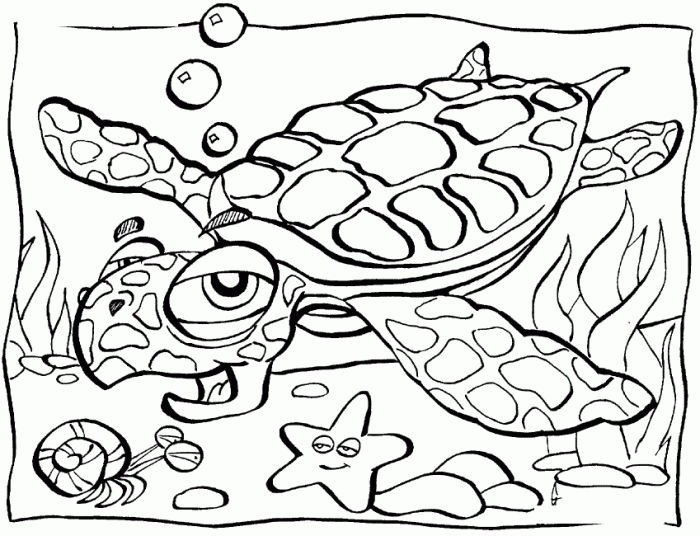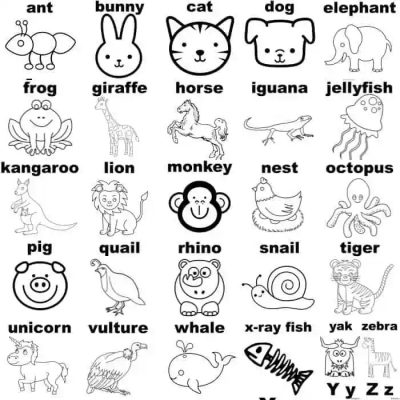Coloring Book Pages Ocean Animals

Target Audience and User Experience

Coloring book pages ocean animals – Ocean animal coloring books cater to a broad age range, each group possessing unique preferences and needs impacting design choices. Understanding these differences is crucial for creating engaging and age-appropriate coloring experiences. Effective design considers not only the visual appeal but also the developmental stage and cognitive abilities of the intended user.The user experience is significantly shaped by the page layout and design elements.
A well-designed coloring book fosters creativity, reduces frustration, and enhances the overall enjoyment of the activity. Poor design, conversely, can lead to disinterest and a negative experience.
Age Group Segmentation and Design Elements
Different age groups respond to distinct visual cues and complexity levels. Younger children benefit from simple designs with bold Artikels and large spaces, while older children and adults appreciate more intricate details and smaller spaces.
- Preschool (Ages 2-5): Large, simple shapes, bold Artikels, and limited details are ideal. Animals should be easily recognizable and presented in a clear, uncluttered manner. For example, a page featuring a single, oversized whale with clearly defined fins and tail, minimal shading, and ample space around the image, allows for easy coloring without overwhelming the child.
- Early Elementary (Ages 6-8): Designs can incorporate more details, such as textures and patterns, but should still maintain a clear structure. Slightly smaller spaces are acceptable, but large areas of color remain important. An example could be a page showing a group of playful dolphins, each with slightly varied poses and some simple textural details like scales or ripples in the water, while still leaving substantial space for coloring.
- Late Elementary/Middle School (Ages 9-12): More complex designs with intricate details, smaller spaces, and the inclusion of backgrounds are suitable. These pages can incorporate shading, perspective, and a greater variety of animals. A page depicting a vibrant coral reef with numerous fish species, each with unique patterns and scales, and a detailed background featuring coral and seaweed, would engage this age group.
- Teenagers and Adults (Ages 13+): Intricate designs with fine details, realistic representations of animals, and complex backgrounds are appropriate. These coloring pages may incorporate elements of realism, artistic style, or even incorporate mandalas or zen-inspired patterns for a more therapeutic coloring experience. An example could be a highly detailed illustration of an octopus with realistic textures and complex patterns on its skin, set against a detailed background depicting the ocean floor.
Dive into the vibrant world of coloring book pages featuring ocean animals – from playful dolphins to majestic whales! If you’re looking for a change of pace, check out this amazing cat animal coloring page for a purrfectly relaxing activity. Then, once you’ve finished your feline friend, return to the underwater adventure and complete your collection of ocean animal coloring pages.
Page Layout and Design for Enhanced User Experience
The page layout plays a crucial role in creating a positive user experience. Careful consideration of elements like image placement, color palettes, and the amount of white space is essential.
- Image Placement: Images should be centrally positioned to avoid overcrowding and ensure sufficient space for coloring. For younger children, larger images are preferable. For older children and adults, smaller images within a larger design are acceptable.
- Color Palettes: Bright, vibrant colors are generally preferred by younger children. Older children and adults might appreciate a wider range of colors, including more muted tones. Color palettes should complement the ocean theme and enhance the visual appeal of the designs.
- White Space: Sufficient white space around the images prevents a cluttered appearance and provides space for creativity. Too much white space can feel empty, while too little can overwhelm the user. The balance should be carefully considered based on the age group.
Educational and Therapeutic Aspects
Ocean animal coloring pages offer a unique blend of entertainment and learning, providing a valuable resource for both education and therapeutic purposes. They can transform a simple coloring activity into an engaging experience that fosters creativity, knowledge acquisition, and emotional well-being. The vibrant colors and captivating imagery of marine life stimulate the imagination while simultaneously providing opportunities for learning and self-expression.Ocean animal coloring pages serve as effective educational tools by introducing children to the diverse world of marine life.
The visual representation of various species, from playful dolphins to majestic whales, sparks curiosity and encourages children to learn more about their habitats, behaviors, and importance within the ocean ecosystem. Furthermore, incorporating educational elements into the coloring activity can enhance knowledge retention and comprehension.
Educational Applications of Ocean Animal Coloring Pages
The visual nature of coloring pages makes learning about ocean animals more accessible and engaging for children of all ages. By pairing coloring pages with supplementary materials, educators and parents can create a comprehensive learning experience that goes beyond simple visual recognition.
- Fact-Finding: Coloring pages can be accompanied by fact sheets or interactive quizzes that test knowledge about the depicted animals. For example, a page featuring a sea turtle could be paired with facts about their lifespan, diet, and conservation status.
- Vocabulary Building: Introduce new vocabulary words related to ocean animals and their habitats. Children can learn words like “cephalopod,” “coral reef,” or “plankton” while coloring related images.
- Habitat Exploration: Coloring pages can depict various ocean habitats, such as coral reefs, kelp forests, and the open ocean. This provides a visual introduction to the diverse environments where different marine animals live.
- Creative Writing Prompts: Encourage children to write short stories or poems about the animals they are coloring, fostering creativity and literacy skills.
- Research Projects: Coloring pages can serve as a springboard for more in-depth research projects. Children can research a specific animal and present their findings in a creative format.
Therapeutic Benefits of Coloring Ocean Animals
The act of coloring itself offers significant therapeutic benefits, particularly when focused on calming and engaging subjects like ocean animals. The repetitive motion of coloring can be meditative, helping to reduce stress and anxiety. The process encourages focus and concentration, providing a mindful activity that can be beneficial for children and adults alike.
Fine Motor Skills Development
Coloring ocean animal pages provides a fun and engaging way to develop fine motor skills and hand-eye coordination. The precise movements required to stay within the lines and fill in intricate details improve dexterity and control, benefiting a child’s overall development. The varied shapes and sizes of the animals present different challenges, gradually building strength and precision in hand movements.
For example, coloring the detailed scales of a fish or the intricate patterns on a seahorse requires greater control and precision than coloring a simple shape like a whale. This gradual increase in complexity helps children develop fine motor skills progressively.
Illustrations and Image Descriptions: Coloring Book Pages Ocean Animals

The following sections provide detailed descriptions of potential illustrations for an ocean animal coloring book, focusing on visual elements to inspire creativity and engagement. These descriptions aim to evoke a sense of wonder and detail, encouraging users to interpret and recreate the scenes in their own unique styles.
Sea Turtle Amidst Coral Reef, Coloring book pages ocean animals
This illustration depicts a green sea turtle gracefully swimming through a vibrant coral reef. The turtle’s shell is a rich, mottled olive green, with hints of brown and yellow, showcasing the natural textures and patterns of its carapace. Individual scutes are subtly defined, giving the shell a three-dimensional appearance. The coral reef bursts with color: bright orange brain coral contrasts with delicate purple sea fans and branching yellow soft corals.
Schools of tiny, iridescent blue fish dart between the coral branches, adding movement to the scene. The water is a clear, turquoise blue, with subtle variations in shade to suggest depth and light penetration. Sunlight filters through the surface, illuminating the scene with a warm, inviting glow.
Playful Penguins on an Iceberg
A group of Emperor penguins playfully interacts on a massive iceberg. Several penguins are huddled together for warmth, their fluffy, black and white feathers clearly defined. Others are engaging in playful antics – one might be sliding down the icy slope, another playfully nipping at a companion’s wing. Their postures are dynamic and expressive, conveying a sense of energy and camaraderie.
The iceberg itself is depicted with a realistic texture, showing cracks, crevices, and variations in the ice’s surface. The ice is a brilliant white in some areas, transitioning to shades of pale blue and grey where the light catches the sculpted surface. The overall scene is crisp and clean, reflecting the stark beauty of the Antarctic landscape.
Whale Breaching
A majestic humpback whale breaches the ocean’s surface in a powerful display. The whale’s immense size is evident, its dark, mottled grey skin contrasting with the bright white of the water spray erupting around it. The spray is depicted with a dynamic, almost ethereal quality, capturing the motion and power of the whale’s ascent. Individual droplets are visible, suggesting a fine mist, while larger splashes create a sense of scale and impact.
The ocean around the whale is a deep, rich blue, transitioning to lighter shades near the surface where the sunlight reflects. The overall feeling is one of awe and wonder, highlighting the magnificence and power of nature.
Underwater Scene with Diverse Marine Life
This illustration showcases a diverse underwater ecosystem teeming with life. Brightly colored fish – orange clownfish, yellow tangs, and blue parrotfish – swim amongst swaying sea anemones in a variety of colors, including vibrant red, pink, and green. The anemones’ tentacles are intricately detailed, showing their delicate yet powerful nature. Other marine life, such as starfish, sea urchins, and a shy octopus peeking from a rock crevice, add to the scene’s complexity.
The seabed is composed of various textures – smooth, sandy patches contrast with rough, rocky areas covered in algae and coral. The overall color palette is vibrant and varied, showcasing the beauty and biodiversity of the underwater world. The composition is carefully arranged to guide the viewer’s eye through the scene, highlighting the intricate details and relationships between different organisms.


